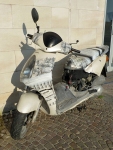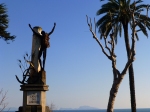The earth is breathing!
There’s been a bit of a hiatus in posts, so I want to finish off the Naples series now and get back to Surrey. The Solfatara, volcanic subject of my last post, is just outside the town of Pozzuoli – a place remarkable for its upward (and downward) mobility.
Pozzuoli is the epicentre of a phenomenon known a bradyseism (meaning slow movement), whereby the ground moves slowly (think millimetres per day) up and down. It’s as though the earth is breathing, and as far as I know this is the only place on earth where it happens. The cause of the movement is the changing pressure and contents of the vast magma chambers below, which I would imagine is a little disconcerting if you’re one of the 83,500 people living in the town.
In the centre of Pozzuoli is the Serapis macellum (Roman marketplace), once thought to be a temple. On its grand pillars, 7 metres up in the air, were found boreholes made by the marine molluscs Lithodamus lithofagus. This provided incontrovertible evidence that the pillars were once completely underwater. Over the centuries the ground has risen and subsided many times, over many metres.
During the period between 1969 and 1972, the town of Pozzuoli rose 1.7 metres. It subsided a bit, then between 1982 and 1984 rose another 1.8m, accompanied by swarms of shallow earthquakes. This resulted in the evacuation and relocation of some 30,000 people, and the abandonment of much of the now-unstable old town. The rest of the town still thrives, however, and the earth moving doesn’t seem to unduly trouble the residents of the town and of the rest of the Campi Flegrei. The respiratory rate of the ground under Pozzuoli is fairly slow at present, which was kind of a relief for us when we visited. 😉
- the ‘temple’ of serapis, a roman marketplace which has been even further underwater.
- make do and mend!
- the italians aren’t going to let expanding magma spoil their enjoyment of bright colours!
- nothing is too sacred for graffiti
- an old church in pozzuoli
- sculpture mirroring tree, or the other way round.
- view over pozzuoli to the islands of procida and ischia







